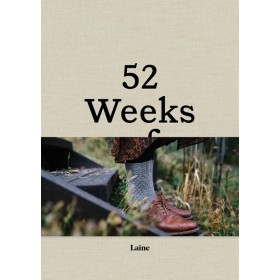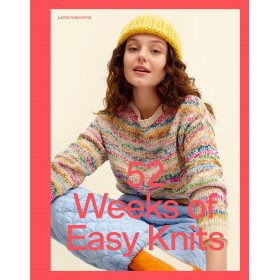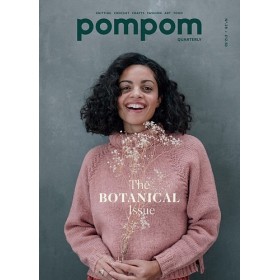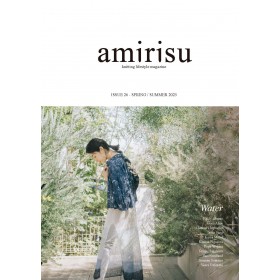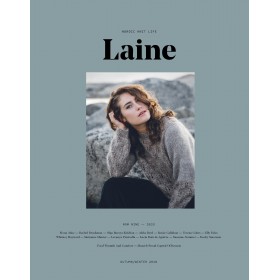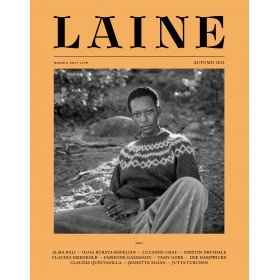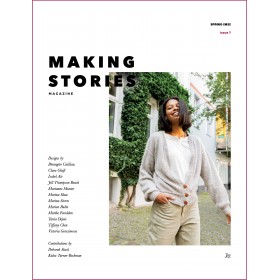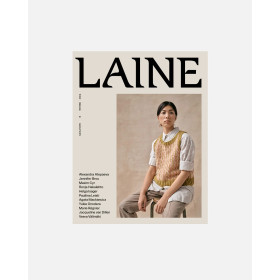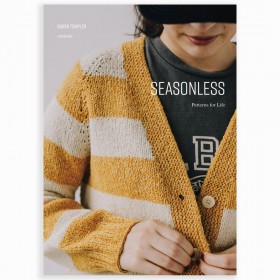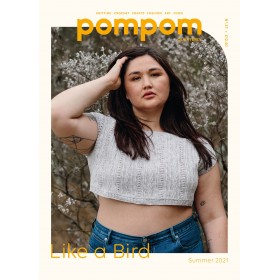 zoom_in
zoom_in
Neons & Neutrals
€32.90
Neons & Neutrals: A Knitwear Collection Curated by Aimée Gille of La Bien Aimée includes 16 patterns from 16 talented designers. It is an eclectic collection of patterns that invites crafters to combine yarn in new and unexpected ways across brands and bases.
Book in French, 200 pages.
Description
Neons & Neutrals: A Knitwear Collection Curated by Aimée Gille of La Bien Aimée is a sequel to Aimée’s first book, the best-selling Worsted. This collection, if possible, is even better and includes 16 patterns from 16 talented designers (4 sweaters, 4 cardigans, 4 shawls, 2 hats, 1 vest and 1 cowl). It is an eclectic collection of patterns that invites crafters to combine yarn in new and unexpected ways across brands and bases. The designs showcase modern knitting at its best, using a variety of techniques and unique and unexpected color combinations. Most of the patterns are photographed in two different samples – worked in different colors and yarns, giving you ample inspiration for your own versions.
The collection celebrates solidarity and cooperation: to showcase the many talented people in the knitting community, Aimée has put together a collection of not only patterns from designers around the world, but yarns from a variety of producers and dyers. All of them work beautifully together and different sizes and price points have also been taken into account.
The book features designs by the following designers: Inese Sang, Maaike van Geijn, Karen Cronje, Anna Husemann, Layla Yang, Caitlyn Turowski, Cecelia Campochiaro, Valerie Ng, Maysa Tomikawa, Florence Spurling, Lotta H Löthgren, Brandi Cheyenne Harper, Marie Régnier, Susan Chin, Brienne Moody and Julia Wilkens.
Visit Neons & Neutrals' Ravelry page to discover all the designs of the book.
°°°
To knit the Harmony cardigan by Brandi Cheyenne Harp (see pictures 2 to 5), you'll need:
SIZES
1 (2, 3, 4, 5) (6, 7, 8)
FINISHED MEASUREMENTS
Chest Circumference: 39.25 (44.5, 48, 53.25, 57) (62, 65.5, 70.5)” / 99.5 (113, 122, 135.5, 145) (157.5, 166.5, 179) cm.
Chest Circumference is the back width doubled. There is an additional 1.5” / 4 cm of ease in the front, and an additional 1.75” / 4.5 cm for the button band for each size.
Recommended ease: 6–8” / 15–20.5 cm of positive ease.
Sample 1 (peach/pink) is a size 2, worn with 1” / 2.5 cm of positive ease.
Sample 2 (gray/multi) is a size 1, worn with 10” / 24.5 cm of positive ease.
MATERIALS
MC: 495 (560, 605, 665, 735) (780, 805, 860) yds / 455 (515, 555, 610, 675) (715, 735, 785) m of super bulky weight yarn.
CC: 200 (210, 250, 255, 260) (300, 335, 375) yds / 185 (195, 230, 235, 240) (275, 305, 345) m of bulky weight yarn.
For buttons (optional): 35 (40, 40, 40, 45) (45, 45, 45) yds / 32 (37, 37, 37, 41) (41, 41, 41) m each of fingering weight and lace weight mohair yarns in complementary colors to MC.
Sample used:
Sample 1 (peach/pink)
MC: 8 (9, 9, 10, 11) (12, 12, 13) skeins of Chunky by Camellia Fiber Company (100% Merino, 68 yds / 62 m – 115 g), colorway Bisque.
CC: 3 (3, 4, 4, 4) (4, 5, 5) skeins of Big Merino by La Bien Aimée (80% superwash Merino, 20% nylon, 77 yds / 70 m – 50 g), colorway Sansa.
Buttons (optional): 1 skein of Merino Singles by La Bien Aimée (100% superwash Merino, 400 yds / 366 m – 100 g), colorway Sansa. 1 skein of Mohair Silk by La Bien Aimée (70% mohair, 30% silk, 547 yds / 500 m – 50 g), colorway Sansa.
Sample 2 (gray/multi)
MC: 9 (11, 12, 13, 14) (15, 15, 16) skeins of Cyrano by De Rerum Natura (100% French Merino d’Arles and Portuguese black Merinowool, 164 yds / 150 m – 100 g), colorway Poivre Blanc (held triple).
CC: 4 (4, 5, 5, 5) (6, 7, 7) skeins of Bulky by The Wandering Flock (100% superwash Merino wool, 109 yds / 100 m – 100 g), colorway Holograph Dreams (held double).
Buttons (optional): 1 skein of Fingering Singles by The Wandering Flock (100% superwash Merino, 400 yds / 366 m – 100 g), colorway Holograph Dreams. 1 skein of Mohair Silk by The Wandering Flock (80% kid mohair, 20% silk, 430 yds / 393 m – 50 g), colorway Holograph Dreams.
Needles:
US 11 / 8 mm 16” / 40 cm circular needles
US 11 / 8 mm 40” / 100 cm circular needles
US 13 / 9 mm 40” / 100 cm circular needles
US 13 / 9 mm DPNs (set of 5)
US C / 2.75 mm crochet hook for buttons (optional)
To achieve correct gauge, use larger or smaller needles if necessary.
Notions: Stitch markers, stitch holders or waste yarn, tapestry needle, 8 (9, 9, 9, 10) (10, 10, 10) buttons – 0.5” / 13 mm wide (optional).
GAUGE
9 sts x 16 rows to 4” / 10 cm on US 13 / 9 mm needles in garter stitch, worked flat in MC, after blocking.
10 sts and 15.5 rnds to 4” / 10 cm on US 13 / 9 mm needles in garter stitch, worked in the round in MC, after blocking.
NOTES ON THE PATTERN
“This piece is called the Harmony Jacket. It uses three different yarn weights: fingering, chunky, and super bulky. Let it include your favorite colors. In visual communication, a color palette is made of colors that work in harmony with each other to express an idea, a feeling, a mood, a vision, a hope, a dream. And in color theory, harmony can be objective. It’s how we arrange colors according to already established color principles like how they meet and match on the color wheel. Harmony can also be subjective. It’s a group of colors that don’t follow the rules but the combination challenges the norm, inspires and delights us. To express unity, you can do what I did and use monochromatic colors — two colors in the same hue that vary in lightness and darkness. In knitting, there are all kinds of ways to bring colors together.
In this pattern, we’re gonna use intarsia to create color blocks in a seamless way. I imagine every color and strand of yarn is a person, a country, a radical idea on how to manifest our wildest dreams for ourselves, for each other, and for the earth with each element different and varying and still coming together in harmony.” Brandi
This sweater uses two different yarn weights in two different colors brought together using simple intarsia techniques. The body is knit flat in one piece from the bottom up. The sleeves are seamless and knit in the round on DPNs. The sleeves have such an interesting construction! They are knit in the round and seamless, you will work 1 RS row and 1 WS row to be able to join the two colors together. Then you will join the body and sleeves to work a raglan yoke. Slipped stitches separate each section and travel up into the collar.
°°°
To knit the Yu 裕 vest by Valerie Ng (pictures 6 to 8), you'll need:
SIZES
1 (2, 3, 4, 5) (6, 7, 8, 9)
FINISHED MEASUREMENTS
Bust Circumference: 36 (40.5, 45, 47.5, 52) (56.5, 61, 63.5, 68)” / 91.5 (103,
114, 120.5, 132) (143.5, 155, 161.5, 173) cm.
Recommended ease: 4–8” / 10–20 cm of positive ease.
Sample 1 (yellow) is a size 2 cropped version, worn with 11” / 28 cm of positive ease. Sample 2 (pink) is a size 4 regular version, worn with 4” / 10 cm of positive ease.
MATERIALS
Cropped version
Yarn A: 452 (488, 551, 614, 673) (731, 828, 873, 935) yds / 413 (446, 504, 561, 615) (668, 757, 798, 855) m of heavy aran-weight or chunky-weight yarn.
Yarn B (in 2 colors): 308 (336, 385, 427, 469) (515, 561, 598, 647) yds / 282 (307, 352, 390, 429) (471, 513, 547, 592) m each of two different fluffy lace-weight yarns. Hold both colors together throughout.
If using a single color for Yarn B: 617 (671, 770, 853, 938) (1029, 1122, 1195, 1295) yds / 564 (614, 704, 780, 858) (941, 1026, 1093, 1184) m of a fluffy lace-weight yarn. Hold 2 strands together throughout.
Regular version
Yarn A: 515 (559, 629, 699, 764) (829, 934, 986, 1055) yds / 471 (511, 575, 639, 699) (758, 854, 902, 965) m of heavy aran-weight or chunky-weight yarn.
Yarn B (in 2 colors): 372 (407, 463, 512, 561) (614, 667, 711, 768) yds / 340 (372, 423, 468, 513) (561, 610, 650, 702) m each of two different fluffy lace-weight yarns. Hold both colors together throughout.
When using a single color for Yarn B: 744 (814, 925, 1023, 1122) (1227, 1334, 1422, 1534) yds / 680 (744, 846, 935, 1026) (1122, 1220, 1300, 1403) m of a fluffy lace-weight yarn. Hold 2 strands together throughout.
Sample 1: Cropped version (yellow) - (Pictures 6 & 7)
Yarn A: 3 (3, 4, 4, 5) (5, 6, 6, 6) skeins of Cyrano by De Rerum Natura (100% French Merino d’Arles and Portuguese black Merino wool, 164 yds / 150 m – 100 g), colorway Poivre Blanc.
Yarn B: 1 (2, 2, 2, 2) (2, 2, 2, 2) skein(s) each of Kumo by La Bien Aimée (75% baby suri alpaca, 24% mulberry silk, 328 yds / 300 m – 50 g), colorways La Bien Aimée Yellow and Dawn.
When using a single color for yarn B: 2 (3, 3, 3, 3) (4, 4, 4, 4) skeins of Kumo by La Bien Aimée.
Sample 2: Regular version (pink) (picture 8)
Yarn A: 5 (5, 5, 6, 7) (7, 8, 8, 9) skeins of Corrie Confetti by La Bien Aimee (50% Falkland Corriedale, 30% natural recycled fibers, 20% La Bien Aimée recycled threads, 250 yds / 230 m – 100 g), colorway Greybow #4 (held double).
Yarn B: 2 (2, 2, 2, 2) (2, 3, 3, 3) skeins each of Kumo by La Bien Aimée, colorways Sunrise and “AS IF”.
NEEDLES:
US 17 / 12 mm 32” / 80 cm or longer circular needles
US 8 / 5 mm 32” / 80 cm or longer circular needles
spare US 10 / 6 mm 16” / 40 cm circular needles, to be used as stitch holder.
To achieve correct gauge, use larger or smaller needles if necessary.
Notions: Removable stitch markers, tapestry needle, a crochet hook in size G / 4.5 mm for seaming.
GAUGE
22 sts x 14 rows to 4” / 10 cm on US 17 / 12 mm needles in Stranded Herringbone Stitch, after blocking.
18.5 sts x 26.5 rows to 4” / 10 cm on US 8 / 5 mm needles in 2x2 ribbing, after blocking.
NOTES ON THE PATTERN
“I love to challenge the status quo, and I guess that’s where it all started! To begin with, I didn’t want a knitted fabric that screams “I am knitted” – so we have the herringbone stitch which has a bit of a woven look. Then I thought, traditionally, one would use a big needle and a relatively thin yarn to knit the herringbone stitch to create a fabric that is not too stiff … but what if I combine a thick yarn and a thin one? The next question: And if playing with yarn weights isn’t fun enough, why not throw in some texture and go for a fluffy yarn? That’s how the stranded herringbone stitch and the Yu vest were born.” Valerie Ng
This vest is worked flat from the top down in pieces then seamed. The front will be worked starting at the shoulders. The two shoulders will be shaped with short rows and increases will be made for the V-neck shaping until two fronts are formed. The two fronts will then be joined and more stitches will be added to the sides for the armhole shaping. Finally, underarm stitches will be cast on and the body will be worked straight to the hem. The back will be worked starting at the shoulders, similarly to the front. Stitches will be cast on for the back neck. The back will be worked to the hem before being sewn to the front piece along the side. Stitches will then be picked up along the hem for the ribbing, likewise for the neck opening and armholes.
- Print only, no digital download code available.
- Printed in Latvia.



































